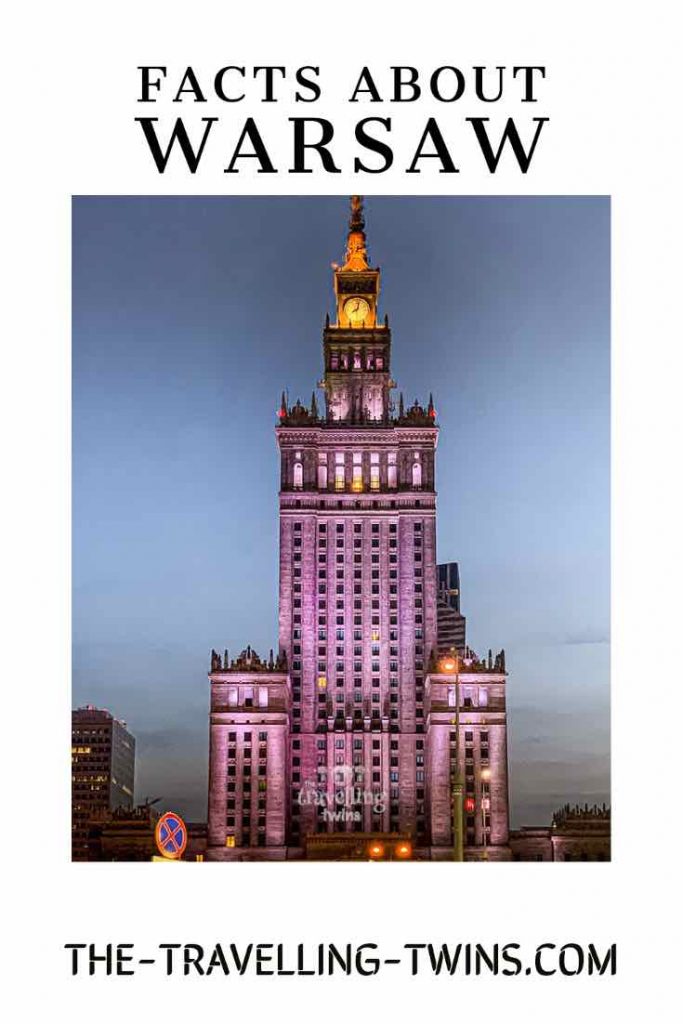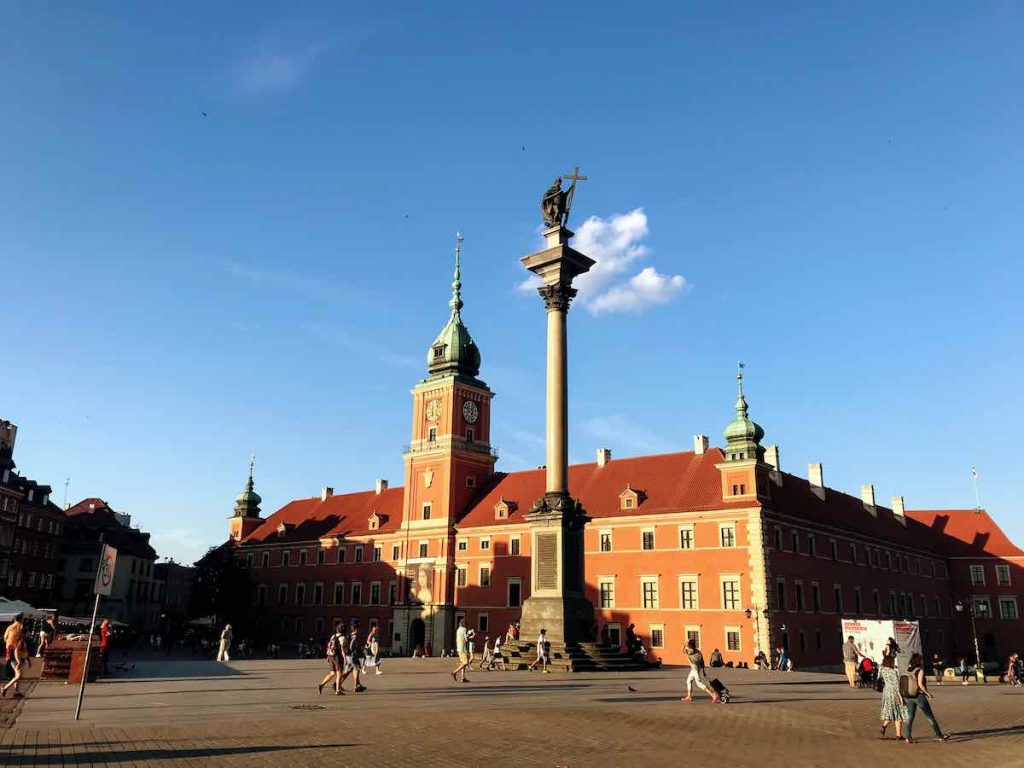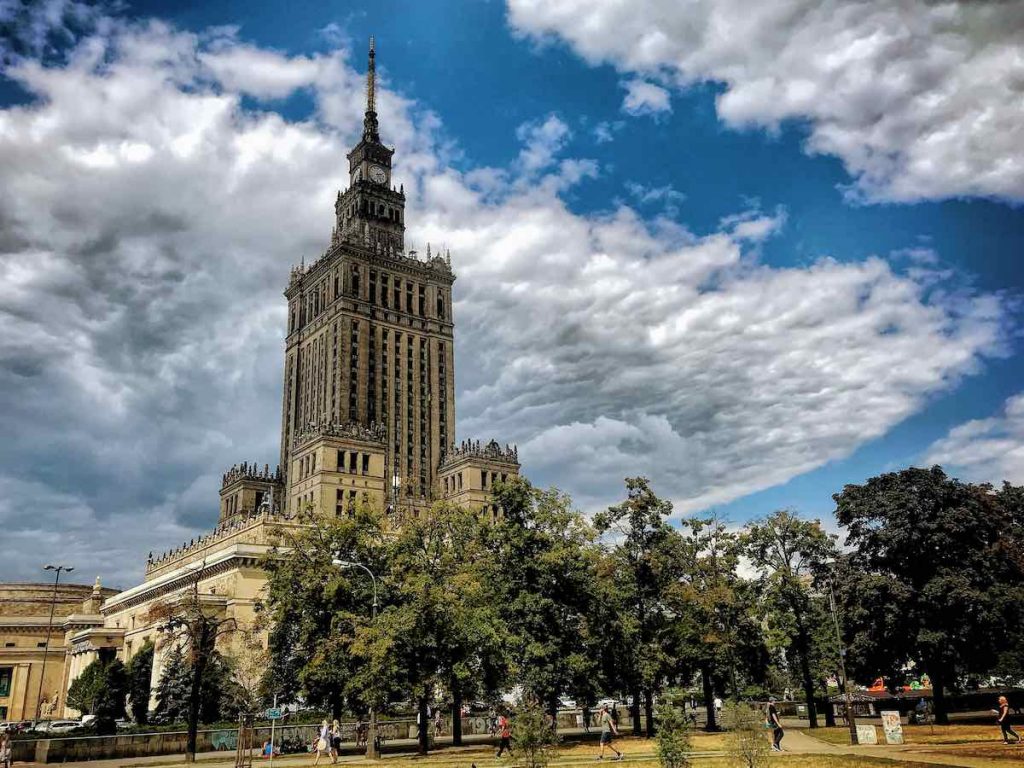Warsaw is the capital of Poland and the largest city in Poland. If you are considering a vacation to Poland, then this blog post will tell you many interesting facts about Warsaw that you might not know.

Location of Warsaw
Warsaw is located in the central-east part of Poland in the Mazovian Voivodship.
The city is sited at an elevation of 100 meters above sea level and it’s sited in the mid course of the Vistula River – the longest river in Poland. Warsaw spreads out on both sides of the river which therefore divides it into the Left Bank and the Right Bank districts
The area of the City of Warsaw is 517.24 km2, and the number of inhabitants in 2019 was 1,777,972.
Green City
Warsaw has 82 parks. Green areas cover 8% of the city area. The oldest parks are the Saski Garden, Krasiński Garden, Łazienki Park and the park in Wilanów.
Warsaw is the only city in the EU with a Nature Reserve within the city boundary – Jeioro Czernikowskie.
When Warsaw became the capital of Poland
The question of when Warsaw became the capital city of Poland is a little bit more complicated than you might think! Although it is usually said that Warsaw has been the capital of Poland since 1596, but this is not entirely true. Warsaw was proclaimed the capital of Poland only in 1918, while the formal provision of its capital did not appear until 1952 in the Polish Constitution. So what actually happened in 1596? At that time King Sigismund III Vasa moved his palace and court from the capital city Kraków to Warsaw, making it the residential city of His Majesty, however, the Country’s capital remained in Kraków..
After World War II, warsaw was confirmed as the capital, although other locations including Kraków, Łódź and Poznań were considered since 85% of Warsaw’s buildings had been destroyed in the war.
Warsaw’s Nicknames
Paris of the north
Warsaw also has many nicknames that people have given the capital. One of them is “Little Paris,” or “Paris of the North”, which is often attributed to the beautiful architecture and historical buildings that make up Warsaw.
Phoenix city
“Phoenix city” was the nickname Warsaw as it rose from ashes like the Phoenix, after the vast destruction during World War II.
Warsaw Name
The city’s name appeared in documents in the 14th and 15th centuries as Warszawa, which is still the native spelling of the city’s name – pronounced “Var-SHAV-a”
The name probably comes from the name Warsz, an abbreviated form of the name Warcisław. The legendary etymology derives the city’s name from the names of Wars and his wife, Sawa.
Warsaw name in different languages
- Polish – Warszawa
- English – Warsaw
- German – Warschau
- Italian – Varsavia
- Spanish – Varsovia
- Yiddish – װאַרשע / Varshe
Warsaw Coat Of Arms
The Coat of Arms of Warsaw features a mermaid – (polish: Syrenka) which according to legend was caught and released a rich merchant, The mermaid rewarded her captor by promising to protect Warsaw and its inhabitants.
I don’t know if the mermaid did such a good job as Poland’s capital has been destroyed in wars at least twenty-five times since its founding! The destruction during World War II largely by the Luftwaffe bombing was only the last of these..
The colours of Warsaw are: yellow and red.
Tourist attractions in Warsaw
The capital city of Poland has something for everyone to do. It’s a vibrant city with art galleries, museums, and numerous historical sites. The icon of the city and main Polish Landmark is probably the Palac Kultury i Nauki (Palace of Culture and Science) – a gift from the USSR and built in the 1950s, with a spire that can be seen all over the city.
Warsaw also has a diverse range of restaurants to cater for all tastes and budgets, from traditional Polish cuisine to international dishes. Warsaw is home to many restaurants that serve sushi or Indian curry alongside typical Polish food such as pierogi and uszka dumplings, kotlet schabowy beef cutlet with fried egg and onion.
Old Town
Warsaw’s Old Town is the most popular tourist destination in Poland and is a Unesco World Heritage Site – but what about the city’s destruction? Well Warsaw’s old town of today was completely rebuilt after the war. Every facade and interior you will find there is actually less than a century old.
The National Museum of Warsaw
The museum has an extensive collection of historical artefacts related to the city and its people.
The Royal Castle
The Royal Castle, which dates back to 1596, is located close to the Old Town and features an impressive collection of paintings and sculptures. Like everything else, the Royal Castle was destroyed during World War II, and has been carefully rebuilt between 1957-1983 to the original design.

Royal Castle in Warsaw is one of the best castles in Poland
Museum of Warsaw Uprising
The Rising Museum shows the history of the brave but hopeless uprising of the Polish against Nazi Germany.
Wilanów Palace and Park Łazienki Królewskie
A trip to the vast Wilanów Palace will take you through beautiful gardens with fountains, statues, lakes, ponds and trees. Between the Royal Castle and the Palace is the 76 hectare Łazienki Królewskie Park – the name means “royal bathrooms” and was originally a location for the bathhouses of a nobleman in the 17th century – and adopted by the King in the 18th century to which it owes it present form,
Famous Varsovian
People from Warsaw are called Varsovians. Varsovians have a strong pride about their city and they are in great company.
Fryderyk Chopin
Fryderyk Chopin, the most famous Polish composer, spent his childhood and youth in Warsaw, later living in France. He was so much connected to Poland that, as per his request, his heart was buried in the Basilica of the Holy Cross Church in Warsaw. Łazienki Park hosts annual Chopin Concerts which are free to enter.
Maria Skłodowska Curie
Maria Skłodowska Curie was born in Warsaw in 1867. She became the first woman to win a Nobel Prize, and the first person (and the only woman) to have won it twice. She is the most famous Polish Female. Her discoveries helped lead to important advances in medicine, science and industry. She discovered two new elements, naming her first one Polonium after her native land.
Robert Lewandowski
The Polish footballer is a striker for the Bundesliga club Bayern Munich but he plays for the Polish national football team.
Buildings in Warsaw
Palace Of Culture and Science
The Palace of Culture and Science was built in the 1950’s as a gift from the people of the USSR to the communist Polish nation. For 65 years it was the tallest building in Poland, and remains one of the world’s largest museums in terms of its total area with more than 123 thousand square meters under its roof. Representing Soviet influence over Poland there have been many calls for its demolition. It hosted concerts by the Rolling Stones and Leonard Cohen in the 1960s and 1980s respectively. Clocks were installed in the tower for the millennium making it one of the tallest clock towers (231 meters) in the world.

The Keret House – the narrowest house
In the gap between two buildings, Polish Architect Jakub Szczesny build the narrowest house in the world. The house is 152 cm at its widest point and 92 cm at its narrowest point. It was designed as a fully functional art installation in which invited artists can live and create. The first tenant was Edgar Keret, an Israeli writer of Polish origin.
http://kerethouse.com/
Tallest Building
Currently, the tallest building in the European Union is Varso Tower, Warsaw designed by Forest and Partners. The building is 310 meters in height, including an 80 meter-tall needle.
Warsaw Stock Exchange
Other Facts about Warsaw
One of the world’s first public libraries was opened in Warsaw in 1747
Over 1,000 trains pass through the Warszawa Zachodnia station every day. It is the busiest station in Poland.
Until 1995, Warsaw was the largest European city without a metro. The first plans to build the Warsaw metro were made as early as 1925.
The name of the Żoliborz district in Warsaw comes from the French word “Joli bord” meaning “charming shore”. The French name was still used in 1801.
Every day at 11.15, a bugle call of Warsaw is played from the Clock Tower (Zygmuntowska) of Warsaw Castle commemorating the moment when the clock stopped on September 17, 1939, during the Luftwaffe bombing.
From 1856, gas lighting began to be used in the city on a large scale, replacing the previously used oil lamps.
Capital of Poland – Facts about Warsaw



Privacy Policy Disclaimer
This website uses affiliate links for income and support.
If you like our website, please consider using these links. You will be directed to the vendor, and we will get a small commission on your purchase price at no increased cost to you.
We have researched facts stated here as far as practicable but please check anything critical before committing your time and money. We do not claim any special knowledge or expertise, and we are not consultants for our readers.